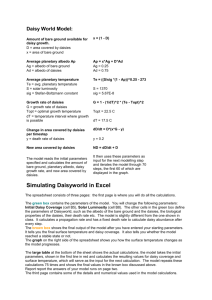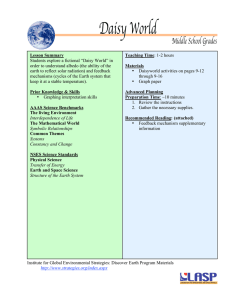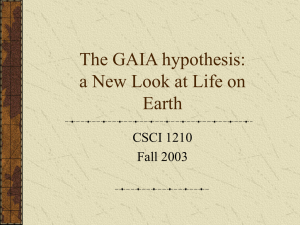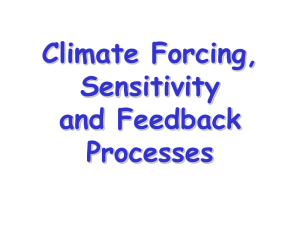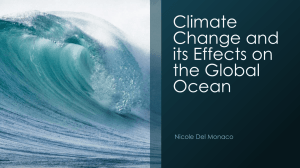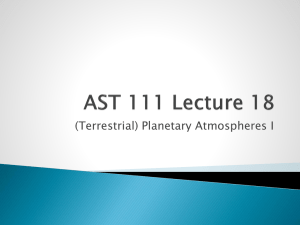Lecture 1
advertisement
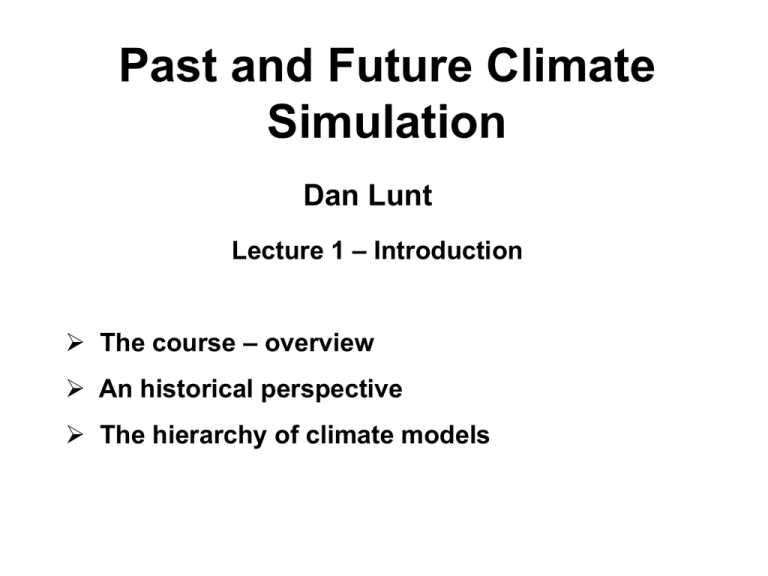
Past and Future Climate Simulation Dan Lunt Lecture 1 – Introduction The course – overview An historical perspective The hierarchy of climate models Aims and Objectives (1) To introduce the concept of General Circulation Models and their fundamental properties, strengths and weaknesses. (2) To illustrate the use of GCMs in palaeoclimate studies, by focusing on 3 key time periods. (3) To illustrate the role of GCMs in future climate studies. (4) To give hands-on experience of evaluating, analysing, and running GCM simulations. ‘Learning Outcomes’ On successful completion, students will be able to: (1) Describe the fundamental basis of GCMs; (2) Discuss the limitations of GCM simulations and their interpretation; (3) Critically assess previous studies which have used GCMs to understand past climates; (4) Evaluate predictions of future climate; 5) Run a simple GCM experiment. Lectures 1) Introduction – history and the model hierarchy 2) General Circulation Models: dynamical core 3) General Circulation Models: parameterisations 4) Future Climate Modelling (1) 5) Future Climate Modelling (2) 6) Last Glacial Maximum Modelling 7) Pliocene Modelling 8) Eocene Modelling Practical Carry out an experiment of your choice with the GENIE-2 model Assessment: write-up of your experiment in the form of a ‘Climate of the Past’ paper Detailed Timetable The Earth System Oldfield, p4 Historical Perspective…. Lewis Fry Richardson 1881-1953 First numerical weather forecast, ~1917 Physically unreasonable – massive rise in pressure Due to lack of filtering “…Imagine a large hall like a theatre, except that the circles and galleries go right round through the space usually occupied by the stage. The walls of this chamber are painted to form a map of the globe. The ceiling represents the north polar regions, England is in the gallery, the tropics in the upper circle, Australia on the dress circle and the antarctic in the pit…. ..A myriad computers are at work upon the weather of the part of the map where each sits, but each computer attends only to one equation or part of an equation... Compute nodes Weather Prediction by Numerical Process 1922 It carries a large pulpit on its top. In this sits the man in charge of the whole theatre…. One of his duties is to maintain a uniform speed of progress in all parts of the globe.… Load balancer Four senior clerks in the central pulpit are collecting the future weather as fast as it is being computed, and despatching it by pneumatic carrier to a quiet room…. High speed interconnect . There it will be coded and telephoned to the radio transmitting station. …. Web portal …Messengers carry piles of used computing forms down to a storehouse in the cellar. Tape archive ….Outside are playing fields, houses, mountains and lakes, for it was thought that those who compute the weather should breathe of it freely.” Air conditioning Jule Gregory Charney 1917-1981 In 1950, the first realistic 24-hour forecast was successfully calculated on the ENIAC…. in about 24 hours University of Bristol supercomputer…Bluecrystal Why Model Climate? Understanding and Prediction Climate theory/understanding Test understanding Climate observations and monitoring Model-data agreement? Application to prediction of climate change, mitigation etc. Climate modelling Hierarchy of models More complex Complex General Circulation Models (GCMs). Include all physics. Do not simulate all components of the earth system, usually atmos, ocean, (veg). Too slow to carry out transient simulations or ensembles. Carry out ‘snapshots’. Earth-system Models of Intermediate Complexity (EMICs). Conceptual/Box Models Include some physics. Include all components of earth-system. Can carry out transient simulations and snaphots. Less complex Include a few or no processes. Can aid understanding. Conceptual models: radiation balance S S E S E Solar energy, S, incident on a planet is ~ constant. Planet absorbs this energy. It starts to heat up and emit its own infra-red radiation (heat), E = σT4 Planet heats up until E is balanced by S. At this point, the temperature is Tbb For our sun, and a planet at the radius of the Earth, Tbb= 6oC Earth: T~10oC If we know E, it is possible to calculate the temperature, T (T=(E/4σ)1/4) S In reality, planets do not absorb all the sun’s energy which his incident. A fraction, α (the ‘albedo’), is reflected. αS S E Planet heats up until S-αS is balanced by E αS For our sun, and a planet at the radius of the Earth, and with Earth’s albedo (~0.3), Tbb= -18oC Earth: T ~ +14oC What is going on? The Earth has an atmosphere! Some constituents of the atmosphere absorb the infra-red energy, E, emitted by the Earth. The atmosphere itself warms up, and in turn emits radiation back towards the surface, heating the surface. Energy balance is obtained with a higher T - the ‘Greenhouse Effect’ (actually, a greenhouse works differently!). S αS A E Atmosphere emits energy A towards the surface. Planet heats up until E+αS is balanced by S+A For the Earth, the most important of these absorbing gases is water vapour! Also CO2, N2O, CH4, CFCs. More IR-absorbing gases => higher T ! Moisture complicates things – clouds etc. For more information, section 1.2 of ‘The Physics of Atmospheres’, John T. Houghton or Chapter 8 of ‘Fundamentals of Weather and Climate’, Robin McIlveen Climate Feedback Parameter Ts = F Y Y is the climate feedback parameter and has units of Wm-2K-1 (Note that sometimes, Ts = λF, where λ = climate sensitivity parameter) If the outgoing longwave radiation is the only process which changes when temperature changes, then YBB = 3.3 Wm-2K-1 It can also be shown that for a doubling in atmospheric CO2, F ≈ 4 Wm-2 Hence in the absence of any other feedbacks, Ts = 4/3.3 = 1.2K For descriptive discussion of feedbacks, see Global Warming by Houghton (p90 onwards) For more quantitative discussion, see Climate Change IPCC (1990) p77 onwards For more mathematical discussion, see Dynamical Paleoclimatology by Saltzman, p 139 onwards Climate Feedbacks: Water Vapour Ts = F Y Water vapour feedback: we know that a warmer atmosphere will hold more water vapour and we also know that water vapour is a radiatively active gas (RAG). Thus the changes in water vapour will amplify the response. This is a positive feedback but (unfortunately corresponds to a negative value of Y). i.e. Ywv < 0 Hence this feedback will reduce Yoverall. Most complex models predict that Ywv ≈ -1.5 Wm-2K-1 and so Yoverall = Y(BB+WV) = 3.3 – 1.5 = 1.8 Wm-2K-1 Hence if the response to a doubling of CO2 is Ts = 4/1.8 = 2.2K NOTE THAT THERE IS SOME ARGUMENT ABOUT THE MAGNITUDE OF Ywv Climate Feedbacks: Ice Albedo Ts = F Y Ice Albedo feedback: in a warmer world, we would expect less ice and snow and hence the surface albedo will decrease. This will result in more solar energy being absorbed, thus further warming climate. This is another example of positive feedback (Yice < 0). Models typically predict that Yice ≈ -0.3 Wm-2K-1 and so Yoverall = YBB + Ywv + Yice = 1.5 Wm-2K-1 Hence the response to a doubling of CO2 is Ts = 4/1.5 = 2.7K NOTE THAT THERE IS SOME ARGUMENT ABOUT THE MAGNITUDE OF Yice Climate Feedbacks: Cloud Feedbacks Ts = F Y Cloud feedback: We do not know how cloud cover will change. In our present climate, satellite observations suggest that the net effect of clouds is to cool the climate system, but this does not tell us how they will respond to a particular climate change scenario. Clouds can influence the radiation budget by many ways: – Total cloud amount – Cloud height – Cloud optical properties (cloud liquid water, droplet radius, fraction of ice etc) Currently we have no confidence in our estimates of the sign of Ycloud. As a very rough approximation, Ycloud ≈ +/- 0.75 Wm-2K-1 (i.e. either a positive or negative feedback) and so Y(BB+WV+ice+cloud) = 0.75 to 2.25 Wm-2K-1 Hence the response to a doubling of CO2 is Ts = 5.3 to 1.8K “Daisy-World” Simple Rules: αS E Solar energy, S, increases linearly, in a similar way to our own sun Experiments: a) No Daisies b) Just White Daisies 1) ‘Bare’ grey soil has albedo 0.5 2) White daisies have albedo 0.75 3) All daisies reproduce according to: Growth rate S 5oC 4) http://zool33.uni-graz.at/schmickl/models/daisyworld.html 22.5oC Temperature 40oC All daisies die at a constant rate (1) Initialisation parameters at low luminosity – predictions? (2) Increase luminosity by hand – daisies appear (3) Increase luminosity further – daisies die (4) Show scenario with no daisies – why shape of graph? (5) Prediction for white daisies and scenario? “Daisy-World” Simple Rules: αS E Solar energy, S, increases linearly, in a similar way to our own sun Experiments: a) No Daisies b) Black and White Daisies, same albedo. c) Just Black Daisies d) Just White Daisies e) 1) ‘Bare’ grey soil has albedo 0.5 2) White daisies have albedo 0.75 3) Black daisies have albedo 0.25 4) All daisies reproduce according to: Growth rate S 5oC 40oC and a factor that depends on the ‘bare’ area Black and White Daisies 5) http://zool33.uni-graz.at/schmickl/models/daisyworld.html 22.5oC Temperature All daisies die at a constant rate Conceptual Models, e.g. Paillard. Conceptual model leads to surprisingly good results, but what is learnt about the system? Paillard, Nature, 391, 378381, 1998. Comprehensive Model ….(GCM, Earth System Model) Newton's Laws of Motion 1st Law of Thermodynamics Conservation of Mass and Moisture Hydrostatic Balance Ideal Gas Law 1990 1995 1990 1995 2001 2001 2007 2007 Surface Temperature: observations Surface Temperature: HadCM3 How good are climate models? EMIC…. For another EMIC, see CLIMBER… Summary • Range of climate models • Each have their own strengths and weaknesses • Simple models (EBM, EMICs) powerful tools for helping our understanding • But perhaps less relevant for future predictions • Most complex models (GCMs) include detailed representation of the physics of climate • But, as we will see, still many approximations • These climate models get used for prediction but are they good enough? • Palaeoclimate can test these models • If data is good enough, and if we know the forcings.
